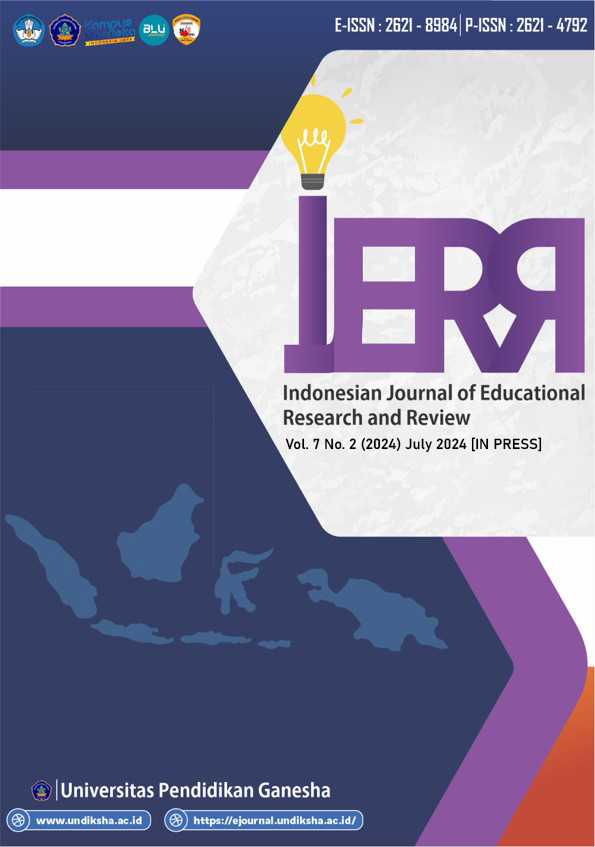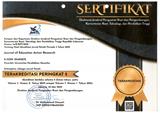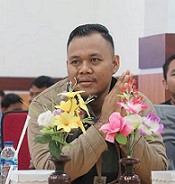Inhibiting Factors of Dance Learning in the Higher Grades of Elementary School Students
DOI:
https://doi.org/10.23887/ijerr.v7i2.80997Keywords:
Analysis, inhibiting factors, danceAbstract
The dance learning process in elementary schools’ experiences imbalances with the demands of the applicable curriculum. In reality, dance learning has not been paid attention to by various parties so that students do not get the opportunity to develop creativity and imagination in dance movements. This research aims to analyze the factors inhibiting dance learning among high grade students in elementary schools in depth. This research includes descriptive qualitative research that uses a case study approach. Data collection techniques through interviews, observation and documentation. Data validity techniques include triangulation of sources and techniques. The data analysis technique used is the Miles and Huberman model. The results of this research indicate that the implementation of dance learning for high class students in elementary schools is still not optimal because there are inhibiting factors in various aspects, including the school, curriculum, school policies, facilities, infrastructure, class management, students, teachers, environment, and society's perception regarding dance learning, so that students' basic development becomes stagnant. The results of this research can be input for various parties to increase collaboration in order to improve the quality of learning in a more progressive direction than before.
References
Arbibah, A.-, Brantasari, M.-, & Khairunnisa, R.-. (2018). Pembelajaran Tari Jepen Dapat Meningkatkan Kecerdasan Kinestetik Pada Anak Usia 5-6 Tahun Di Kelompok Bermain Darussakinah 02 Tenggarong Seberang Tahun Ajaran 2016 / 2017. Jurnal Warna : Pendidikan Dan Pembelajaran Anak Usia Dini, 2(1), 44–55. https://doi.org/10.24903/jw.v2i1.188.
Asriyanto, A. M. A., Muhibbin, A., Widyasari, C., Prastiwi, Y., & Ramawati, L. E. (2022). Etnomathematic Exploration Study on The Traditional Dance of Kethek Ogleng. Jurnal Pedagogi Dan Pembelajaran, 5(2), 293–302. https://doi.org/10.23887/jp2.v5i2.48695.
Becker, K. M. (2013). Dancing through the school day: How dance catapults learning in elementary education. Journal of Physical Education, Recreation & Dance, 83(3), 6–8. https://doi.org/10.1080/07303084.2013.763665.
Bernard, M., Akbar, P., Ansori, A., & Filiestianto, G. (2019). Improve the ability of understanding mathematics and confidence of elementary school students with a contextual approach using VBA learning media for Microsoft Excel. Journal of Physics: Conference Series, 1318(1). https://doi.org/10.1088/1742-6596/1318/1/012035.
Bernard, M., & Senjayawati, E. (2019). Developing the Students’ Ability in Understanding Mathematics and Self-confidence with VBA for Excel. JRAMathEdu (Journal of Research and Advances in Mathematics Education, 4(1), 45–56. https://doi.org/10.23917/jramathedu.v4i1.6349.
Dharma, I. M. A. (2019). Pengembangan Buku Cerita Anak Bergambar Dengan Insersi Budaya Lokal Bali Terhadap Minat Baca Dan Sikap Siswa Kelas V Sd Kurikulum 2013. Journal for Lesson and Learning Studies, 2(1), 53–63. https://doi.org/10.23887/jlls.v2i1.17321.
Diana, L., Noer, S. H., & Gunowibowo, P. (2016). Efektivitas Pembelajaran Discovery Ditinjau dari Kemampuan Pemecahan masalah Matematis dan Self Confidence. Jurnal Pendidikan Matematika Universitas Lampung, 4(1). https://doi.org/http://jurnal.fkip.unila.ac.id/index.php/MTK/article/view/10600.
Fathinnaufal, M., & Hidayati, D. (2020). The implementation of character education in elementary school. Journal of Educational Management and Leadership, 1(2), 31–38. https://doi.org/10.33369/jeml.v1i2.11687.
Herawaty, D., Widada, W., Adhitya, A., Sari, R. D. W., Novianita, L., & Falaq Dwi Anggoro, A. (2020). Students’ ability to simplify the concept of function through realistic mathematics learning with the ethnomathematics approach. Journal of Physics: Conference Series, 1470(1), 12031. https://doi.org/10.1088/1742-6596/1470/1/012031.
Huberman, A., & Miles, M. (2012). Understanding and Validity in Qualitative Research. In The Qualitative Researcher’s Companion. https://doi.org/10.4135/9781412986274.n2.
Julianti, T. T. (2017). Penerapan Kurikulum Berbasis Kearifan Lokal Di Kelas VI SD Negeri Sendangsari Pajangan Bantul Daerah Istimewa Yogyakarta. Universitas PGRI Yogyakarta, 1–9. http://repository.upy.ac.id/id/eprint/1633.
Kudinov, S. I., Kudinov, S. S., Mikhailova, O., Kudinov, V. S., & Imomberdieva, N. M. (2020). Different self-attitude indicators in students and their self-realization in a university. International Journal of Cognitive Research in Science, Engineering and Education, 8(3), 47–59. https://doi.org/10.23947/2334-8496-2020-8-3-47-59.
Lucero, R. (2021). Effects of instructional materials in multimedia computer-assisted instruction in teaching folk dance. Edu Sportivo: Indonesian Journal of Physical Education, 2(1), 40–50. https://doi.org/10.25299/es:ijope.2021.vol2(1).6364.
Miskawati, M. (2019). Upaya Meningkatkan Kreativitas Anak Dalam Pembelajaran Seni Tari Melalui Strategi Belajar Sambil Bermain di TK Islam Sa’adatul Khidmah Tahun Pelajaran 2016/2017. Jurnal Ilmiah Dikdaya, 9(1), 45. https://doi.org/10.33087/dikdaya.v9i1.123.
Mulyani, D., Ghufron, S., Akhwani, & Kasiyun, S. (2020). Peningkatan Karakter Gotong Royong di Sekolah Dasar. Lectura: Jurnal Pendidikan, 11 (2), 225–238. https://doi.org/10.31849/lectura.v11i2.4724.
Muzdalifah, A., Arafat, Y., & Selegi, S. F. (2023). Pengaruh Model Project Based Learning Berbasis Etnosains terhadap Hasil Belajar SBdP di SD Muhammadiyah Prabumulih. Scientia: Jurnal Hasil Penelitian, 8(1), 37–46. https://doi.org/10.32923/sci.v8i1.3372.
Pitriani, S. (2020). Analisis Materi Pokok Seni Budaya Dan Prakarya (Sbdp) Kelas III MI/SD. AULADUNA: Jurnal Pendidikan Dasar Islam, 7(1), 60. https://doi.org/10.24252/auladuna.v7i1a6.2020.
Rahayunita, C. I., & Werdiningtyas, R. K. (2020). Pengembangan Media Paspop pada Materi SBdP di Sekolah Dasar Kecamatan Jabung. Jurnal Bidang Pendidikan Dasar, 4(2), 164–177. https://doi.org/10.21067/jbpd.v4i2.4555.
Raheb, K. E., Stergiou, M., Katifori, A., & Ioannidis, Y. (2019). Dance interactive learning systems: A study on interaction workflow and teaching approaches. ACM Computing Surveys (CSUR), 52(3), 1–37. https://dl.acm.org/doi/abs/10.1145/3323335.
Rambe, R. N. K. (2018). Penerapan Strategi Index Card Match Untuk Meningkatkan Hasil Belajar Siswa Pada Mata Pelajaran Bahasa Indonesia. Jurnal Tarbiyah : Jurnal Ilmiah Kependidikan, 25(1), 93–124. https://doi.org/10.30829/tar.v25i1.237.
Rosala, D., & Budiman, A. (2020). Local Wisdom-Based Dance Learning: Teaching Characters to Children through Movements. In Elementary School Forum (Mimbar Sekolah Dasar), 7(3), 304–326. https://eric.ed.gov/?id=EJ1280444.
Sani, I. M., & Yuliasma, Y. (2022). Peningkatan Hasil Belajar Tari Siswa Menggunakan Model Pembelajaran TAGUNTA Di Kelas III SDN 29 Ganting Utara Kota Padang Improving Student Dance Learning Outcomes Using the TAGUNTA Learning Model In Class III SDN 29 Ganting Utara , Padang City. Journal Sendratasik, 11(2), 278–289. https://doi.org/10.24036/js.v11i2.114391.
Wijayanti, D., & Pratomo, W. (2019). Pendidikan Karakter Melalui Model Pembelajaran Kreatif Bagi Siswa Sekolah Dasar (Studi Di Sdn Mendungan 2 Yogyakarta). Taman Cendekia: Jurnal Pendidikan Ke-SD-An, 3(1), 276–282. https://doi.org/10.30738/tc.v3i1.4291.
Xing, Z., & Qi, Y. (2022). Development of creativity in physical education teachers using interactive technologies: involvement and collaboration. Education and Information Technologies, 0123456789. https://doi.org/10.1007/s10639-022-11422-9.
Yetti, E.-. (2012). Pengaruh Model Pembelajaran dan Kemampuan Gerak Tari Terhadap Kecerdasan Emosional Anak Usia Dini. Jurnal Seni Budaya Dan Panggung, 22(2), 213–224. https://doi.org/10.26742/panggung.v22i2.63.
Yetti, E., & Jakarta, U. N. (2021). The Influence of Dance Instructional Strategy and Teacher’s Pedagogy Competence on Classroom Climate. İlköğretim Online, 20(1), 642–650. https://doi.org/10.17051/ilkonline.2021.01.54.
Downloads
Published
How to Cite
Issue
Section
License
Copyright (c) 2024 deasylina da ary, Markamah

This work is licensed under a Creative Commons Attribution-ShareAlike 4.0 International License.
Authors who publish with the Indonesian Journal of Educational Research and Review (IJERR) agree to the following terms:
- Authors retain copyright and grant the journal the right of first publication with the work simultaneously licensed under a Creative Commons Attribution License (CC BY-SA 4.0) that allows others to share the work with an acknowledgment of the work's authorship and initial publication in this journal.
- Authors are able to enter into separate, additional contractual arrangements for the non-exclusive distribution of the journal's published version of the work (e.g., post it to an institutional repository or publish it in a book), with an acknowledgment of its initial publication in this journal.
- Authors are permitted and encouraged to post their work online (e.g., in institutional repositories or on their website) prior to and during the submission process, as it can lead to productive exchanges, as well as earlier and greater citation of published work. (See The Effect of Open Access)












